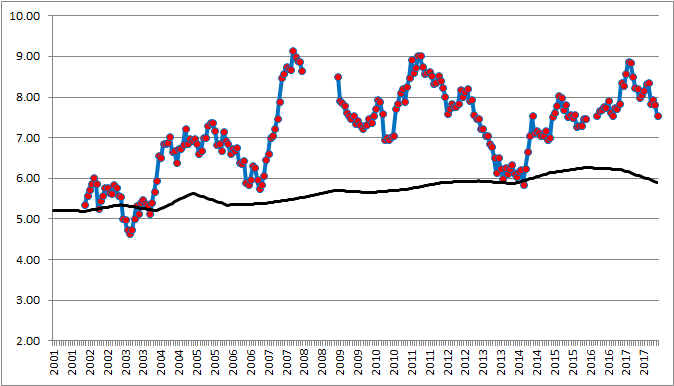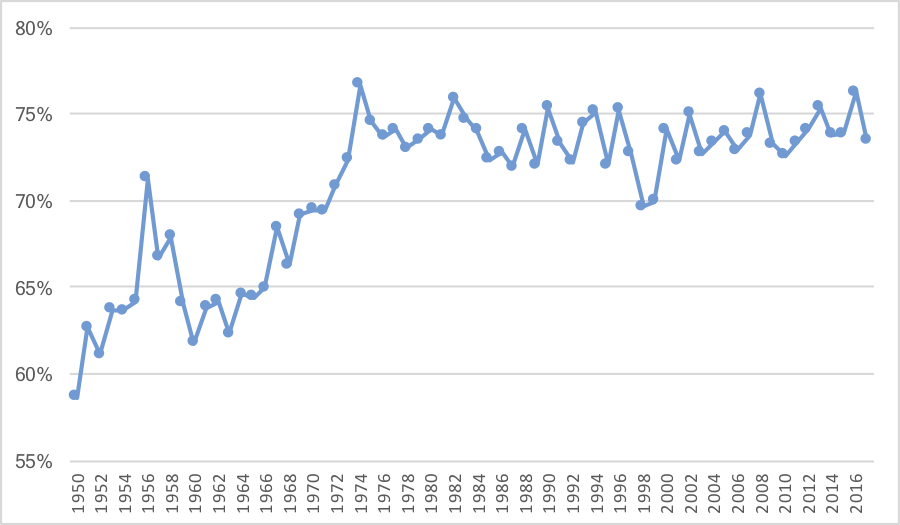If you knew before today that Ryan Fitzpatrick and Nathan Peterman were going to have historic performances today, you probably would have guessed that they would have been historically bad. In that case, you’d be half right.
Let’s start with Peterman, one of the least pedigreed and deserving week 1 starters in recent memory. Well, against the Ravens, he completed 5 of 18 passes (27.8%) for just 24 yards with 0 TDs and 2 INTs. That’s a -3.67 AY/A average, since interceptions are worth -45 yards. Add in Peterman’s 3 sacks for 12 sacks, and his ANY/A average is -3.71 (sidenote: it’s remarkable that adding 3 sacks of -4 yards each barely moves the needle! That’s how bad Peterman was). It was just the second time since 2016 that a quarterback had at least 14 pass attempts and an AY/A of -3.5 or worse; the first was Peterman in his first start last year against the Chargers.
Perhaps more “impressive” is that even if we ignores the interceptions and the sacks, Peterman was flat out horrible. He gained 24 yards on his 18 attempts, a pitiful 1.33 Y/A average. In 1997, Tony Graziani of the Falcons also threw for 24 yards on 18 attempts (and also threw 0 TDs and 2 INTs); in fact, since 1982, Graziani and Peterman are the only two quarterbacks to throw 18+ passes and average under 1.35 yards per attempt. Change the thresholds a little bit — say, 15 passes, 1.50 Y/A — and Peterman is still the only quarterback to hit that mark since the end of the 2009 season (and the games in 2009 both involved significant weather).
Buffalo mercilessly pulled Peterman after 10 drives. Those drives yielded one first down and just 21 yards! The Bills opened the season with seven straight three-and-outs!

Given the modern passing environment, I’m not sure a quarterback can do much worse than what we saw yesterday in Baltimore.
On the other hand, we have Ryan Fitzpatrick. He completed 21 of 28 passes for 417 yards and 4 TDs. He didn’t take any sacks or throw any interceptions, giving him a yards/attempt average of 14.9 and an ANY/A and AY/A average of 17.75!
How good is that? Since 1970, just five quarterbacks have thrown for 400+ passing yards and also averaged 17.7 AY/A or better. One was Joe Namath against the Colts in 1972, a game that might be the best passing performance game ever considering the era and opponent. Mark Rypien had a memorable 6-TD game against the Falcons in 1991 and Nick Foles had a 7-TD game against the Raiders; both of those games make the 400/17.7 AY/A cut-off. The fourth game was Steve McNair in 2003, and the fifth was Fitzpatrick on Sunday.
Fitzpatrick picked up a first down on 17 of his 28 dropbacks. How remarkable is it to gain a first down on 61% of your pass plays? No team did it last season, and just two (2016 Falcons, 2016 Cowboys; one time each) did it the year before.
It remains to be seen how good the Saints are, but let’s say (perhaps optimistically) that New Orleans allows 5.3 ANY/A again this year in all other games. That would mean Fitzpatrick, who had a 17.75 ANY/A average over 28 dropbacks, would have been 12.45 ANY/A above expectation, which translates to 349 Adjusted Net Yards above expectation. That would rank in the top 15 all-time.
So yeah, it was a pretty darn good day for Fitzpatrick and the Bucs offense. And it’s not the only remarkable game of his career: don’t forget the 6 TD, 0-sack, 0-INT game in 2014 where he averaged over 10 yards per pass.
For now, Bucs fans can sit back and enjoy this remarkable drive chart.














